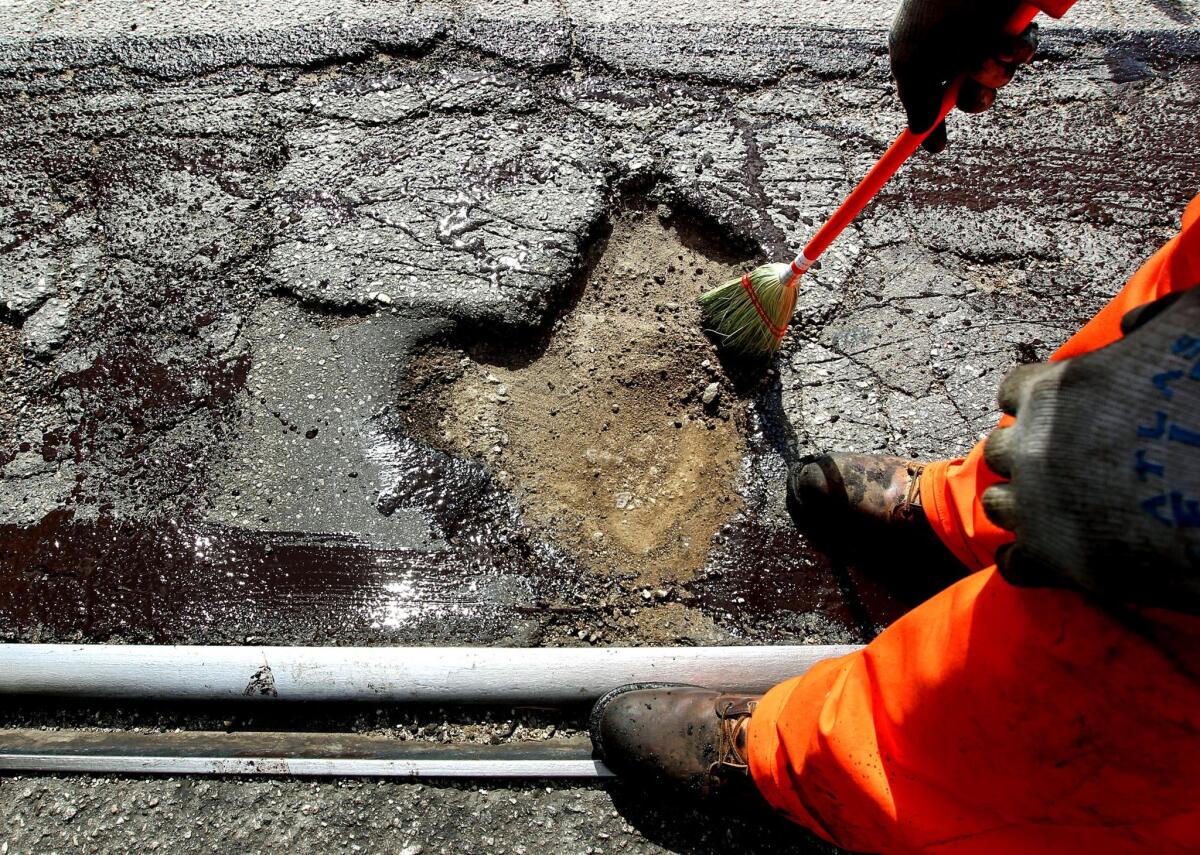L.A. street repair agency riddled with problems, audit finds

- Share via
City auditors revealed Thursday that the bureau charged with fixing and maintaining Los Angeles’ streets is beset with problems that include failing to collect or spend hundreds of millions of dollars, keeping shoddy records and neglecting to address the most heavily trafficked roads first.
The woes of L.A. streets are already obvious to anyone on wheels or foot: Streets so pockmarked or broken that the city gives them a D or F grade make up nearly 40% of city roadways. Mike Eveloff, president of the advocacy group Fix the City, argued that the battered roads imposed a “hidden tax” on Angelenos, who end up paying for cars damaged by potholes and other untallied expenses.
Repairing the worst roads has been estimated to cost nearly $4 billion. But auditors for City Controller Ron Galperin pointed out a host of shortcomings in the way the Bureau of Street Services uses the money it already has — a finding that could make city officials hesitant to ask taxpayers for more. Earlier this year, Los Angeles lawmakers abandoned the idea of seeking a sales tax increase to repair streets and sidewalks, leaving it unclear how they would pay for the vast backlog of work.
Until Angelenos are confident that street funding is being properly spent, “I think people are going to be very reluctant — and correctly so — to say, ‘Let’s just throw more money at it,’” Galperin said.
Street Services Director Nazario Sauceda declined to answer questions about specific audit findings, saying he still had to review the final report, but promised to take any necessary action.
“We take this audit very seriously,” Sauceda said, standing alongside Galperin at a news conference Thursday outside a city asphalt plant off Olympic Boulevard.
Auditors found that Street Services has been paying steeper prices to make its own asphalt than it would if the city bought it from an outside vendor. The city pays nearly $66 per ton to produce asphalt, while private companies have provided it for less than $40 per ton, according to the audit.
Sauceda said the higher cost stemmed from outdated equipment that was unable to recycle as much old pavement. Officials said the Olympic facility would need nearly $18 million in upgrades to make asphalt at costs as low as outside vendors. The city plants provide more than a third of the asphalt used to fix city roads.
Meanwhile, the bureau failed to collect money that could have paid for mending streets. Because it miscalculated fees, the bureau never collected $190 million from utility companies that cut into streets to replace water or electric lines dating back to 1998, the audit found. Galperin said it was unclear how much — if any — could now be recovered.
In addition, $21 million that was supposed to fund street repairs was left unspent between 2010 and 2013; instead it was returned to funding sources, the report said.
Systemic problems also abounded. In an introduction to the audit, Galperin wrote that “a great deal of information about the bureau’s activities is incomplete or simply missing,” with scant records to show how many potholes it had filled. Completion reports were missing for 15 of the 25 street paving projects scrutinized by auditors, the report said.
Auditors also calculated that nearly 43% of the salary costs attributed to the workers who resurfaced or rebuilt streets went into vacation, sick time, training and administrative tasks instead of repair work. Typically, government agencies try to hold those costs to 25% or less, but the bureau has no targets for how efficiently it uses its workers.
In addition, Galperin said, officials did not consider traffic volume or heavy vehicle loads when prioritizing road repairs. That left some of the most important streets in the worst shape.
Sauceda said the department uses a “state-of-the-art” system to assess street conditions. But Galperin said it operates too slowly.
Galperin said new software and hardware could help the bureau better track street conditions and manage its work. The report also spotlighted a piece of equipment that Street Services had abandoned — a $151,000 “Pothole Killer” that patches streets faster and cheaper than a team hoisting shovels, according to the report. However, the bureau stopped using the machine because of logistical problems. Street Services officials contended that it was designed to be used in cold weather. Yet the technology was used in Brazil before the World Cup, auditors wrote.
The report focused chiefly on the period from 2010 to 2013, just before Mayor Eric Garcetti took office. Garcetti said in a statement that since then, his office has worked with Street Services to improve its performance, getting 2,200 lane miles repaved in the last year and creating the Neighborhood Blitz program to prioritize repairs based on community concerns.
Though Sauceda refused to comment on the findings, the audit stated that Street Services officials said they disagreed with several points in a draft version. Sauceda said he was proud of his bureau, which he said had undergone a 40% staff reduction over the last five years. But other city leaders said the findings underscored the need for change.
Angelenos “lack the trust in how we’re spending dollars,” Councilman Joe Buscaino said. “Before we go to voters, we need to ensure that we have our fiscal house in order.”
Follow @LATimesEmily for breaking news from City Hall
Follow @bposton for data analysis and investigations
More to Read
Sign up for Essential California
The most important California stories and recommendations in your inbox every morning.
You may occasionally receive promotional content from the Los Angeles Times.












